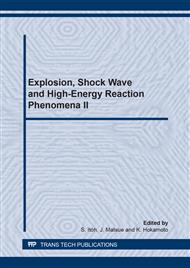p.92
p.101
p.109
p.114
p.120
p.126
p.132
p.138
p.144
Numerical Simulation of Underwater Explosive Welding Process
Abstract:
Recently, underwater explosive welding shows its advantage in some difficult-to-weld combinations such as material with thin thickness, high hardness, and fragile quality. The pattern of the typical wave morphology in the interface of the welding specimen indicates the suitability of the selected experimental parameters and sound strength of the laminates. For the existence of the water, traditional Gurney formula and Aziz formula can not directly be used to evaluate the velocity and acceleration process of the flyer plate. Numerical simulation is necessary and irreplaceable for existing knowledge. Underwater explosive welding process was numerically simulated by ANSYS/LS-DYNA to explore the underwater shock wave and deformation process of the flyer plate. Velocity and pressure distribution of welding plates were obtained. The velocity of the flyer plate could satisfy the minimum velocity in explosive welding. It was found that water prevented the gross distortion and ensured the integrity of the composite laminate. Welding rate was increased by expanding the size of the explosive.
Info:
Periodical:
Pages:
120-125
Citation:
Online since:
July 2013
Authors:
Price:
Сopyright:
© 2014 Trans Tech Publications Ltd. All Rights Reserved
Share:
Citation:


